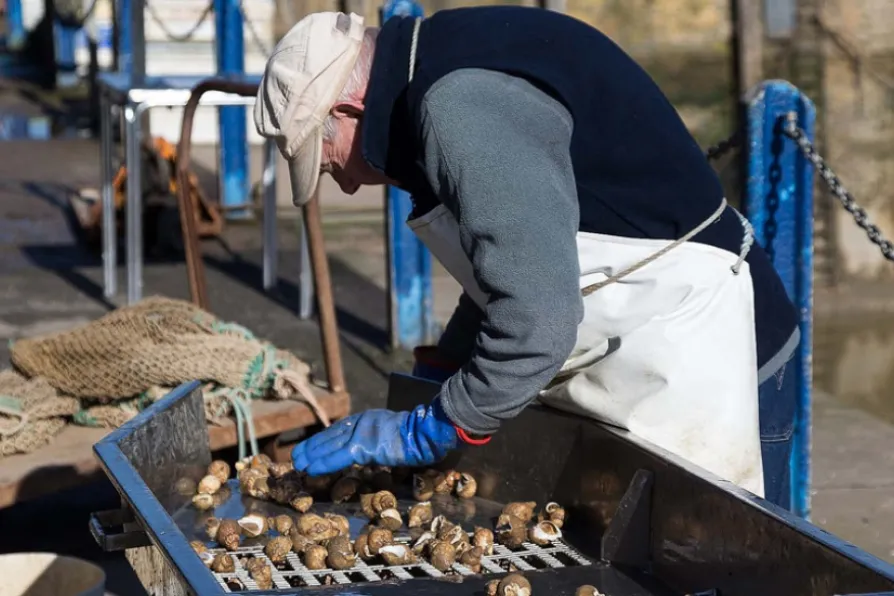Durham Miners’ Association general secretary ALAN MARDGHUM speaks to Ben Chacko ahead of Gala Day 2025

 Washing and sorting the freshly cought whelks ready for cooking at Whitstable Harbour, Kent
[Pic: Smudge 9000/Creative Commons]
Washing and sorting the freshly cought whelks ready for cooking at Whitstable Harbour, Kent
[Pic: Smudge 9000/Creative Commons] CHATTING to a young (well, if 34 counts as young) mate recently, I don’t know who looked more horrified. Him at hearing I had never played a video game, or me at discovering he had never eaten or even heard of a winkle.
I’ll leave him to write about video games but use my space this week to praise the humble and much underrated — but sustainable — delicacy that is the winkle and a few of its close relatives among the shellfish of old England.
I’m not talking about crabs and lobsters nor the many varieties of shrimp, prawn, crevettes and crayfish that I so love to eat and cook with.
This week I’m concentrating on those humble creatures who make their watery home inside some kind of elaborately shaped hard calcium shell.
I’m writing this now because of the old, but far from accurate, advice that you should only eat shellfish in the months with an “R” in them.
There is little truth in this old story and remember it only applies to certain species. Even then, it is more about sustainable fishing than eating quality.
Certain species are breeding during the summer months so not only is it best to let them get on with it but at these times their eating quality will be poor.
Freezing too makes it less important to follow the R rule. My advice is to trust your supplier, if they are selling the fish you are probably fine eating them.
Most seaside resorts still have a stall or two selling shellfish including my absolute favourites the curly little black shelled beast and the large white sea snail — otherwise known as the winkle and the whelk.
In France you cannot buy one of the famous fruits de mer — a huge feast of mixed shellfish — without its share of tiny, shiny winkles and fat whelks.
Sadly most British diners seem too scared to try them yet will pay high prices for prawns that might have been factory farmed in south-east Asia.
Meanwhile so many of the shellfish harvested from English waters get shipped off to feed foreign appetites. Most of the British winkle harvest ends up in France where a tiny dish of these delicacies are served with an aperitif before a smart meal.
If I have tempted you, there is an unfortunate catch. Unless you live near the coast, winkles are not always easy to buy. I’ve rarely found a supermarket that sells them.
If your local fishmonger can’t do any better, you could turn to an online supplier or do what I do and save winkles for a special treat next time you go to the seaside.
How different it was when I was a boy in the late 1960s in north London where on Sunday afternoons we still had a winkle seller calling door to door carrying his dripping wooden tray on his head and ringing his bell. He must have been one of the last of these colourful street vendors.
When I was courting my wife Ann — how old fashioned that sounds — the family told the story of her grandfather who would serve winkles to Sunday high tea guests but if he didn’t like the look of you he would not give you a pin.
Ann’s mum was much kinder and I knew I was in her good books when I saw she had extracted every one of my generous portion of winkles and laid them out on buttered brown bread.
The other easy source of winkles in those days were the seafood stalls that seemed to be outside so many pubs. One or two of these can still be found if you know where to look.
The larger sea-snail is the whelk and they are certainly much easier to find than winkles. Whelks can be chewy but at their best they are wonderful. They are being used by imaginative cooks in exotic dishes like stir fries.
Another shellfish we don’t seem to appreciate enough today is the clam. Even though there are plenty of clams in Britain, most notably the humble but delicious and thankfully still easily available cockle.
Larger clams are not so easy to find and can be expensive when you do. One of my favourites is the razor clam.
A good source of these are Chinese supermarkets, for razor clams are popular with Chinese cooks.
Another variety of shellfish becoming more easy to find on supermarket fish counters are mussels. Fresh, alive and ready for the simple cooking process or increasingly packaged already cooked in various sauces they are as cheap as the chips you need to serve them with.
Scallops are an expensive but popular bivalve recognisable by its pretty, fan-shaped shell. Very simple to fry, they go well with pork products such as chorizo or best of all as part of a real luxury full English fried breakfast.
Oysters were once so cheap that apprentice agreements banned them being served more than three days a week. Not any more, sadly the typically love-it-or-hate-it oyster is expensive. The supermarkets tend to order for the weekend so if you are lucky you may as I do find some real bargains on Mondays.
Native oysters are home grown, rare and even more expensive.
More common and a deal cheaper are rock or Pacific oysters. Add a few drops of lemon juice, shallot vinegar or Tabasco, and swallow raw but do chew them as they go down. It is my idea of heaven but only if I can’t find a plate of whelks and winkles.
Now pass me that Video Game.



















